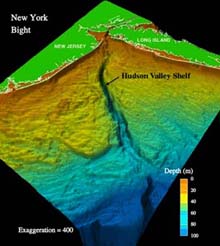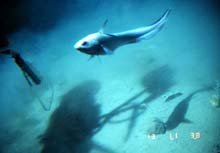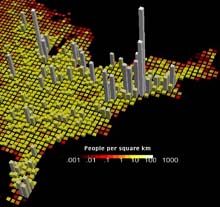Ocean Dumping
Recent studies suggest that the deep ocean bottom supports habitats as diverse as any community on land or in shallow water. The discovery that the deep sea may be every bit as rich as a tropical rainforest comes at a time when land use is at a premium. In the 21st Century, we will have to decide what to do with the vast amount of waste that a growing population -- projected to double from five billion to 10 billion in the next century -- will produce. The oceans, which cover 70 percent of the Earth's surface, are likely to receive consideration as a waste-management option.
Currently, ocean dumping is generally banned worldwide. The motivation for banning ocean dumping gained momentum when contaminated wastes from sewage-derived microorganisms were discovered at public beaches, shellfish beds were contaminated with toxic metals, and fish were infected by lesion-causing parasites. Coastal areas continually impacted by nutrients in waste products (primarily nitrogen) that run off the land eventually suffer from increases in toxic algal blooms and decreased oxygen levels, both of which can kill fish populations.
To some, the deep-sea floor may seem safe from the human disturbances that threaten terrestrial and coastal ocean environments. Yet, most natural and artificial wastes -- such as sewage sludge, mining tailings, fly ash from power stations, dredged spoils from harbors and estuaries, dangerous synthetic organic compounds and packaged goods -- make their way to the sea floor over time.
Studying Deep-sea Biodiversity and Dumping
To determine the impact of waste disposal on bottom-living animals, the National Undersea Research Program (NURP) recently supported numerous research projects in the oceans and Great Lakes. Scientists examined the effects of dumping on living organisms and deep-sea biodiversity, as well as the transmission of contaminants back to the human population.

Bathymetry of the coastal ocean in the New York-New Jersey metropolitan region. Click on image for a larger view.
In the most detailed study ever conducted related to the impacts of ocean dumping, NURP-funded scientists documented the impact of 42 million tons of wet sewage sludge dumped 2,500 m (8,000 ft) off the Mid-Atlantic coast between 1986 and 1992. One of the most significant environmental impacts detected at the 106-mile Dumpsite, so named because it lies 106 nautical miles southeast of New York Harbor, was the restructuring of a deep-sea community.
In a series of 233 core samples taken along a 176-kilometer track off the coast of New Jersey and Delaware, Drs. Fred Grassle and Nancy Maciolek found an incredible diversity of animals, most of which were previously unknown. They identified 798 different species, 171 families, and 14 phyla at around 2,100 m (6,720 ft) -- a sampling that revealed much richer life at those depths than earlier samples had suggested.
As they sampled sites to the north and south, the number of new species doubled, suggesting that species diversity was much richer than ever imagined. The researchers generalized that nearly 10 million species could be found in every sq km of the sea floor beneath depths greater than 1,000 m, excluding the abyssal depths (3,000-6,000m).
Fate and Effects of Sewage Sludge
For six years, the NURP-sponsored studies attempted to determine the fate and effects of sewage sludge on the sea floor. All of the evidence indicated that the sludge material dumped by barges significantly effected the metabolism, diet, and composition of the organisms living there.
Chemist Michael Bothner, of the U.S. Geological Survey, confirmed the presence of sludge in sediments, as well as silver levels 20 times higher at the dumpsite than at an unaffected area. To make this determination, Bothner and his colleagues used the submersible Alvin to collect the silver samples in sediment cores. They also were able to observe how contaminants penetrated to a depth of 5 cm below the sea floor as organisms living in the sediments burrowed through them. During a 10-month sampling period, however, researchers noted seven occasions where the currents were strong enough to resuspend the contaminated sediments. During the same period, chemist Hideshige Takada, of Tokyo University, and Bothner, reported elevated levels of linear alkylbenzenes (LABs), which are widely used as surfactants in synthetic detergents, and coprostanols, a substance found in animal feces, at the dumpsite.
The increased flux of sludge caused measurable changes in the benthic (sea floor) ecology near the dumpsite. Drs. Van Dover, Grassle, and other colleagues observed a tenfold increase in the abundance of urchins, starfish and sea cucumbers at the dumpsite, and observed the sea urchins' ingestion of sludge-derived organic matter. The researchers believed that a long-term disposal program that introduced sludge into the food web would result in the restructuring of the sea-floor community, favoring species able to exploit the organic material available in sewage sludge.

An eel pout, about 0.5 m long, seen from Alvin's starboard viewing port while collecting re-suspended sediment at the 106-Mile Dump site. Click on image for a larger view.
Sludge disposal at the 106-Mile Dumpsite was curtailed in July 1992. This provided additional opportunities to examine the long-term dispersal and effects of waste material in the deep-sea environment, Bothner said. He found that silver levels in sediment samples had begun to decline after the dumping stopped. In subsequent studies, Bothner, and chemical oceanographers Elizabeth Lamoureux and Bruce Brownawell of the State University of New York at Stony Brook, found that while LABs had tapered off, elevated levels of organic contaminants, including PCBs and PAHs in surface sediments, could still be detected around the dumpsite. Dr. Van Dover found that the density of benthic communities at the dumpsite was decreasing and that the ingestion of sewage-derived organic matter was also subsiding at the dumpsite.
The Future of Ocean Dumping
While the effects of sludge dumping appeared to be abating in the vicinity of the 106-Mile Dumpsite, an additional chapter of the story remains to be written. Levels of silver appeared to be on the increase 50 nautical miles south of the dumpsite, as did the densities of sediment-dwelling organisms. According to a 1993 study by Dr. Grassle, Paul Snelgrove, associate chair in fisheries conservation at Memorial University of Newfoundland, and Rosemarie Petrecca, a senior marine scientist at Rutgers University, this suggests that the recovery of the dumpsite led to changes in other habitats, as resuspended materials were transported south.
While deep-sea dumping has been banned, there are many other ways that waste makes its way into water bodies. In Lake Ontario, for example, an average of one ton of waste material discharged from every ship that leaves port is deposited on the lake bottom, according to a recent NURP study. This legal practice, called cargo sweeping, which involves removing from the deck such wastes as iron ore pellets, coal, slag, limestone, construction aggregate, and possibly ash, is leaving a "footprint" on the bottom of the lake. The problem is likely to be even more serious in the Great Lakes with more shipping traffic than Lake Ontario.
In a study led by Brownawell, NURP-funded researchers used a remotely operated vehicle to collect sediment samples at the bottom of Lake Ontario. Their work confirmed that cargo sweeping left waste materials in plots along the bottom, and that these wastes could pose adverse effects on benthic invertebrates. Amphipods, benthic crustaceans at the base of the food chain, appear to be in decline in shipping lanes. Whether this will have an impact on predatory fish in the Great Lakes is unknown, but the observation prompted the U.S. Coast Guard to move shipping lanes away from critical fish spawning areas throughout the Great Lakes where cargo sweeping is a common practice.
Many questions remain about the potential short- and long-term effects of toxic compounds accumulating in deep-water sediments. Some argue in favor of deep-ocean dumping, because the material is diluted as it sinks, and reamins stable on the sea floor. The present body of research, however, suggests that dilution does not completely abate the effects of dumping, nor does the waste sit still once it gets to the bottom. By establishing a long-term observatory at the 106-Mile Dumpsite, Dr. Grassle hopes future research will provide a clear picture of the effects of deep-sea dumping.
This essay is adapted from a more detailed one. Click here to read it.
Sign up for the Ocean Explorer E-mail Update List.

































